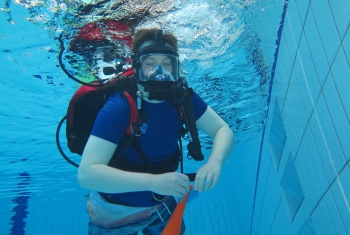Kyle Freeman has begun a journey towards achieving his goal of becoming a professional artist.
The 20-year-old, from Ceduna on South Australia’s remote west coast, is flourishing, thanks to the right supports.
Kyle is discovering his own potential and identity as a young First Nations man from Wirangu country, with support from the NDIS.
‘I just love drawing. It makes my heart feel warm,’ Kyle says.
‘I get my ideas from inside my head, and sometimes from my phone.’
Kyle had a stroke as a child, leaving him with a traumatic brain injury and weakness on the right side of his body. He has limited movement and strength in his right arm and hand.
When practising his art Kyle is supported by First Nations artist Sharon Gray, a support worker employed by regional NDIS provider Eyre Futures Inc.
‘When I first started working with Kyle, I didn’t know he was interested in art,’ Sharon said.
'So when I saw him drawing it was great because it gave us something to work on together. But he does his own drawings, in his own style.’
Kyle’s artistic style draws more on modern themes than traditional First Nations imagery.
‘I just want to start my own story, and do my own art,’ Kyle says.
Kyle is following in the footsteps of established First Nations artists from his area.
‘Sometimes I take Kyle over to the Ceduna Aboriginal Culture Centre to look at the art there,’ Sharon says.
‘It’s a good way for him to learn about our culture and see what the other artists are doing.’
Another one of Kyle’s goals is to gain more mobility and strength.
To achieve that goal, Kyle has NDIS funded physiotherapy and hydrotherapy, and occupational therapy to help his posture.
‘I’ve got to keep doing the therapy to get stronger,’ Kyle says.
Some of Kyle’s artwork is inspired by how he sees himself in the future, including one meaningful drawing of a muscular man.
‘That’s future-me. I’ll get there by exercising,’ Kyle says.
Eyre Futures Inc. manager and NDIS support coordinator Kerrie Harrison is deeply invested in Kyle’s physical and creative development.
She is impressed by his progress.
‘Our first goal was to have Kyle sit at a table for more than an hour, as it was very tiring for him and he would want to go home early,’ Kerrie says.
‘Now, we’re driving him home at 5 o’clock! The difference in his physical resilience in only 12 months has been like night and day.’
Kyle’s other goal is to be more independent with self-care tasks and housework.
Support workers have helped Kyle to learn how to find specials at the local Foodhub charity, and to cook his own meals.
‘We look up what’s cheap, go and buy it, cook it up and I take it home to mum. I’ve cooked sausages and fried rice,’ Kyle says.
Helping Kyle achieve his potential is a team effort.
Kerrie says providers in remote areas like Ceduna must be resourceful and rely on local networks.
‘In a remote area we’ve got to use what is available to us,’ Kerrie says.
‘For example, we organised for Kyle to spend time in a local art gallery,’ Kerrie says.
‘Kyle got good experience in an art related workplace, and he also got exposure to over 70 artists who contributed to that gallery. And it’s made possible through NDIS workplace assistance funding.’
The NDIS has made a big difference to Kyle, and those supporting him are rewarded by his sense of humour, and by watching him grow.
‘I’m a busy man,’ Kyle says.
‘At Eyre Futures, I get friendship and support.



